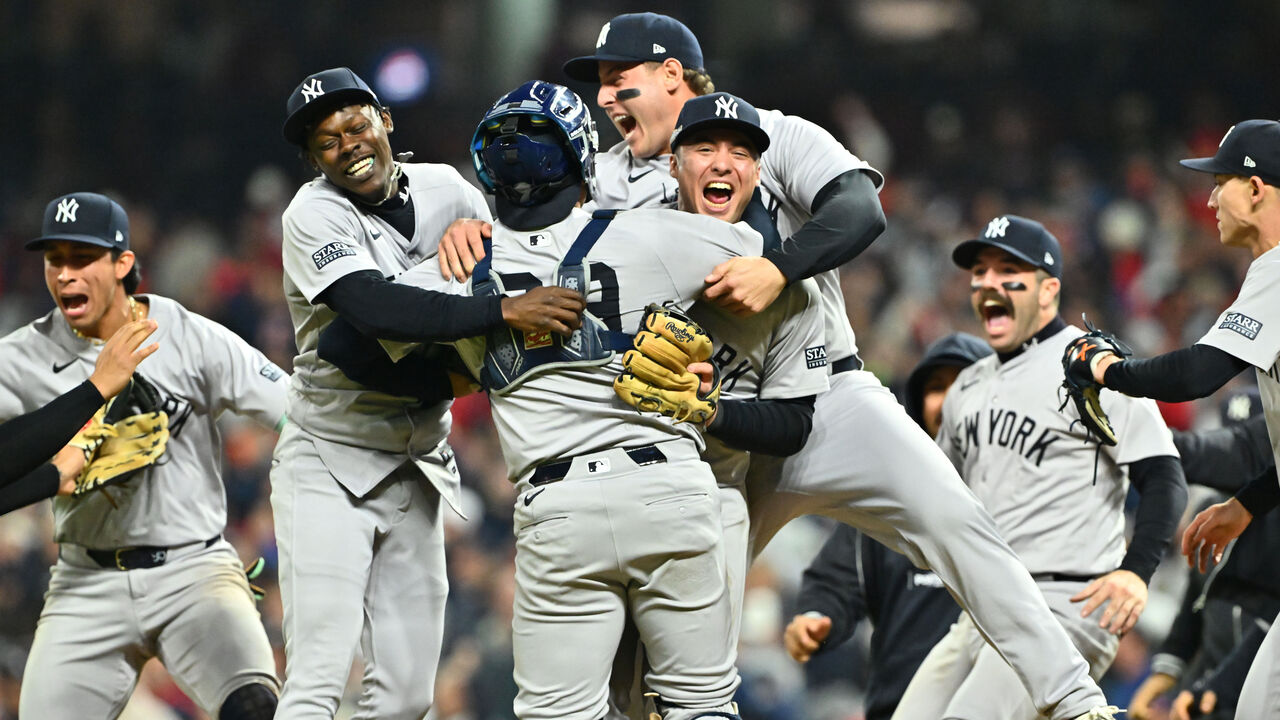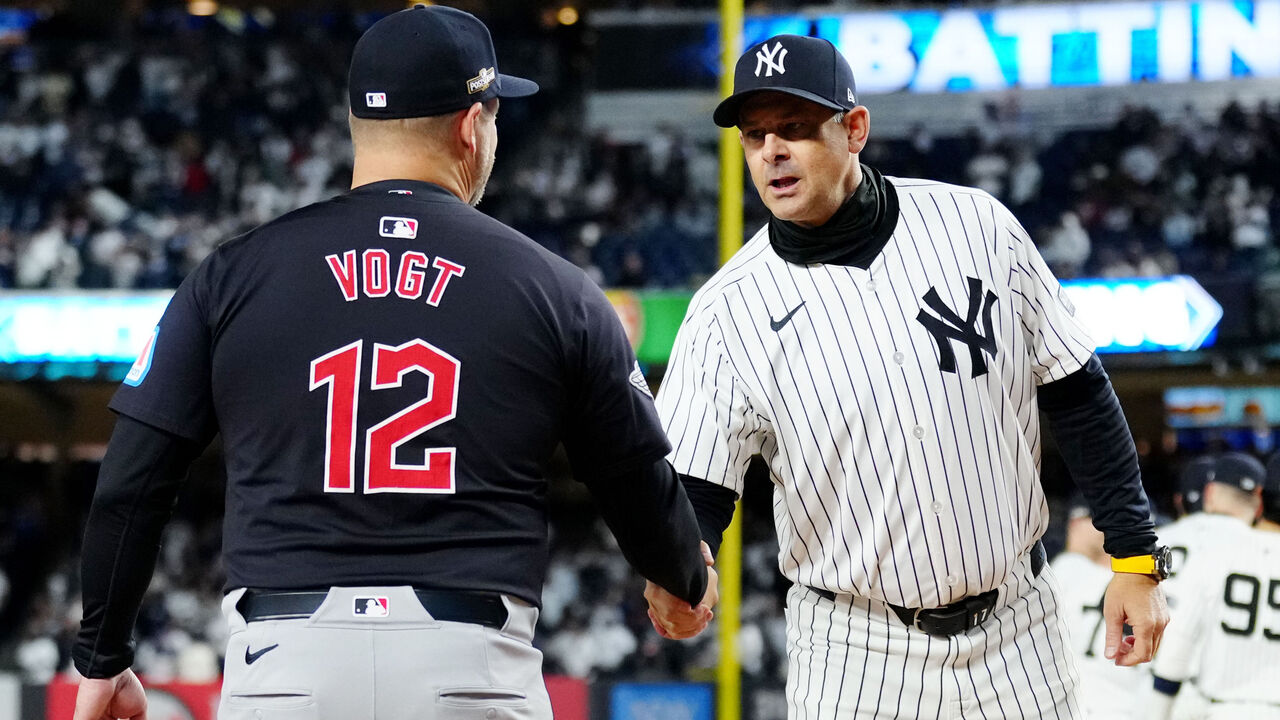Decisions and star power: How the Yankees returned to the World Series
Wins and losses are rarely tied to one player - or one decision.
Decisions and performances are stacked, the cumulative result leading to game outcomes.
But pivotal performances shape narrative and legacy.
And an all-time moment combined those things when the Yankees won Game 5 of the ALCS Saturday night and clinched a trip to the World Series.

Against the Yankees, there are few easy decisions, few opportunities to relax.
For instance, Cleveland manager Stephen Vogt elected to stick with starter Tanner Bibee into the sixth inning in Game 5. At that moment, Bibee became the only starting pitcher Vogt trusted to handle a third trip through the middle of an opponent's order this postseason.
Bibee had pitched well. He navigated through five scoreless innings, offering the Guardians' elite but overextended bullpen some much-needed length. Cleveland's relievers entered the night having pitched a whopping 62% of the club's innings this postseason. They were tiring, their velocities were decreasing, and locations were being missed more often.
So as Giancarlo Stanton walked to the plate with two outs and a man on in the sixth - and a much less intimidating presence in Jazz Chisholm Jr. on deck - Vogt had Bibee pitch to Stanton. Stanton had struck out twice on the night, but he'd also homered three times in the first four games of the series.
Decisions. Decisions.
On the full-count offering, Guardians catcher Bo Naylor called for a low-and-away slider to try and end the inning with a chase. Worst case, Stanton wouldn't offer and he'd walk.
Naylor emphatically moved his glove, the target, to below the zone. But Bibee missed the location. While his slider is typically excellent, this one hung in the zone, seemingly set on a batting tee for Stanton, who crushed it into the left-field bleachers. The blast left his bat at 118 mph.

Bibee knew by the sound alone. He dropped his hands to his knees, his eyes facing the ground, without turning around.
The choices to stick with Bibee - and pitch to Stanton - can be questioned. But it's never just the decision. Bibee didn't execute. Stanton did.
"Stanton leads all active MLB hitters in home runs. He’s on pace to finish his career with over 500 homers. But the way he’s done it has carved out a niche all of his own."
— Baseball America (@BaseballAmerica) October 20, 2024
(🎥 @Yankees)pic.twitter.com/exS8mmMTyV
Stanton now has seven career hits against the Guardians in the postseason. All seven are home runs.
After the game, Vogt, the rookie manager, was asked about how he handles his decisions.
"The way I do it is I ask myself what's true. You can write a narrative in your head and spin yourself down a negative path and beat yourself up and second-guess and go back, but what's true is you made what you thought was the best decision in the moment and then you leave it behind," Vogt said. "I have a mentor of mine that says learn the lesson, leave the event. You leave the event behind and you learn everything you can from it, and there's no going back."

One criticism of Vogt, who helped the Guardians exceed expectations in the regular season, was that he too often challenged the Yankees' best hitters in this series.
He trusted his elite bullpen arms to a fault.
Stanton, Aaron Judge and Juan Soto combined for nine home runs and 16 RBIs over 55 at-bats.
The rest of the Yankees combined for one homer and six RBIs over 113 at-bats.
If the Yankees' star-power advantage wasn't evident in examining payroll alone, where the Yankees held more than a $200-million edge, it was in simply seeing the teams lined up across from each other in pregame introductions. Judge, Stanton and Soto simply towered over the Guardians.
But while the Stanton blast deflated to the home crowd, it only tied the score. The series wasn't over.
Zeroes followed. The Guardians looked to be in an advantageous position in the 10th inning.
The bottom of the Yankees' lineup was due up against one of Cleveland's best bullpen arms in Hunter Gaddis, who relieved Emmanuel Clase. Vogt decided not to push his struggling closer, Clase, for a second inning.
If the Guardians could avoid the Yankees' lineup rolling over, the advantage would swing in their favor.
But with one out and a runner on to begin the 10th, Cleveland shortstop Brayan Rocchio appeared to rush the transition of securing a toss from second baseman Andrés Giménez to start a potential double play. The ball glanced off his glove. No out was recorded, ultimately allowing Soto to stride to the plate with two runners on base - and two outs - the score tied 2-2.

If Rocchio fields the flip cleanly, Soto never bats in the inning. In an alternate universe, the Guardians are on a team charter flight back to New York.
But Rocchio dropped the ball.
And while defeat and victory are accumulative in nature, narrative is not.
There are also pivotal plays, singular swings, pitches, and decisions that are inflection points for a game, for a legacy.
These are the high-leverage spots where star power plays up, where overwhelming talent forces better execution from an opponent and can better capitalize on mistakes.
And there is perhaps no hitter better suited for the pivotal moment than Soto.
Moments like that one on Saturday night illustrate why the Yankees paid a hefty price to acquire one year of Soto's services last winter. Soto is set to be a free agent after the season, and he could be rewarded with record compensation.
With Soto approaching the plate, Vogt had to pick between poisons: pitch to Soto or Judge, the AL MVP favorite, who was waiting on deck. There was no good choice.
Throughout the series, the Guardians tried to avoid Soto more than anyone else. He walked a team-high four times, including an intentional walk to face Judge with the bases loaded in Game 2. (Judge produced a sacrifice fly).
There are reasons to avoid Soto. He's harder to strike out than Judge. He's less likely to chase an out-of-zone pitch. He was locked in, having already homered twice in the series. And he's been a better playoff performer than Judge.
For his career, Judge has hit .203 in the postseason with a .761 OPS, while Soto's hit .278 with a .906 OPS.
Soto embraces the moment. His confidence borders on arrogance, as seen in his trademark shuffle after a take of an out-of-zone pitch and the way he stares down pitchers. His confidence is backed by his uncommon talent. He's on a Hall of Fame track. Through all age 25 seasons in MLB history, Soto ranks 23rd in wRC+ and on-base percentage.
The argument to pitch to him was likely this: Judge is better with breaking balls than Soto, and the former was unlikely to see a changeup from Gaddis. The slider and changeup are Gaddis' top pitches.
Gaddis also held lefties to .172 average on the season.
So Gaddis pitched to Soto.
An anxious Progressive Field crowd was on its feet as Gaddis began with a first-pitch breaking ball that missed inside. Soto shuffled, staring back at the mound.
Gaddis followed with another breaking ball, perfectly located at the bottom of the zone for a strike.
The third pitch was a hanging slider, which Soto tried to yank into the seats. He fouled it away harmlessly. Gaddis had gotten away with a mistake. Rather than scolding himself for an opportunity missed, Soto glared toward Gaddis, again nodding his head up and down.
Soto then fouled off the fourth pitch, a changeup. He again nodded his head yes. With each wasted pitch, the advantage swung to Soto. Familiarity with release point and stuff so often favors the hitter.

Said Soto afterward: "I mean, I was all over him. I was all over him. That was the only thing I was thinking. I was just saying to myself, 'You're all over that guy. You're all over that guy. He ain't got anything.' And just try to make good contact, and I did."
Soto then fouled away another changeup, and then a slider. He hadn't yet seen a fastball, but for good reason: Soto crushes fastballs, especially high ones.
But, perhaps trying to surprise Soto, Naylor and Gattis agreed to throw an elevated fastball.
Naylor again exaggerated the location, calling for the pitch above the zone.
Let's take a pitch-by-pitch look back at Juan Soto's breathtaking AB in the 10th inning! ↩️#MLBTonight | #Postseason pic.twitter.com/rt4mYnPVR0
— MLB Network (@MLBNetwork) October 20, 2024
Gaddis didn't quite get the pitch high enough. Soto had homered on a similar pitch location in the first inning a night earlier against Gavin Williams. He did it again, lofting a high-arcing blast over the right-center field wall. The Yankees fans in attendance, perhaps 10% of the crowd, roared.
Soto paused down the first-base line before thumping his chest while facing New York's bench, which spilled out of the dugout.
In the middle of it all was Yankees manager Aaron Boone, who had far fewer difficult decisions to make.
"(Soto) has just such an ability to seize the moment," Boone said. "Every big moment that he finds himself in the middle, he delivers over and over and over again for us."
It was an all-time plate appearance by Soto.
It was the pivotal play built upon the accumulation of stars doing star-level things, along with questionable decisions and faulty execution by Cleveland. And the Yankees celebrated on a cool fall night, soaking the visiting clubhouse in champagne and beer, knowing they have only one more step to complete.
Travis Sawchik is theScore's senior baseball writer.